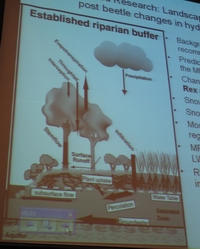Beetle Research Update
By 250 News

UNBC’s Vice President of Research Max Blouw and Conference Chair Dr. Bill Wilson of the Canadian Forest Service in Victoria discuss the conference moments before officially opening the session
In his opening remarks, Dr. Bill Wilson noted the he is blessed because he has an abundance of researchers and resources, at the same time Wilson said he is cursed because of those same reasons.
Wilson says when they started research there were three areas that became the focus of study.
Threat of a spread: While Wilson says this is more of a threat for Alberta, there was still a fair amount of work on the beetle and its spread pattern and how that can be controlled. There is also some focus on the threat to jack pine and just how dynamic that equation will be. Wilson says the beetle would have to work a little harder to find food in a jack pine forest, but none the less, it can survive. “When you have a pest outbreak of this scale you are gong to have some nasty impacts” Those impacts include habitat issues
Economic issues have also been addressed. B.C.’s forest economy is based on supplying lumber to the housing market, and while that has been booming in the past four or five years, “Like all bubbles, that is about to come to an end” says Wilson who says the big question now is how can we take that fibre and maintain the markets we have worked so hard to establish. They also looked at the energy side “Certainly the Province has expressed a keen interest in asking if some of this fibre can be used in energy production”
The third area being examined is Social impacts…what can you expect at the community level. “We looked at 6 communities including Prince George on what it means for employment and tax revenues.”
Wilson says clearly when you pull as many trees out of a region as must be done, there will be some hydrology issues.
 Hydrology issues form a long lasting impact on our forests. While the researchers know (or can predict) spring run off from a normal snow fall in a normal regenerating stand, they are still trying to figure out what the runoff will be in a deteriorating stand. In other words, will streams have enough water, will they be too high, will they be dry? Early indications are that snow disappears faster in a dead stand of trees.
Hydrology issues form a long lasting impact on our forests. While the researchers know (or can predict) spring run off from a normal snow fall in a normal regenerating stand, they are still trying to figure out what the runoff will be in a deteriorating stand. In other words, will streams have enough water, will they be too high, will they be dry? Early indications are that snow disappears faster in a dead stand of trees.
Economic…. Summer harvesting is suffering as sites are more sensitive because they are wetter than normal (the water table is higher because there are no roots of healthy trees to absorb the water) that means equipment can’t get in to the site to harvest, and roads cannot be built.
Stephane Dube with the Ministry of Forest Office says while the Vanderhoof region is getting the same amount of total annual precipitation, more of it is coming in the form of rain between April and later October. According to Dube, the canopy of the forest also acts as a natural umbrella, reducing the amount of water that reaches the ground. In a healthy stand, that canopy can intercept 27% of the precipitation, while in a beetle kill stand, that interception factor is down to 5%.
He says the there are serious drainage issues and that could impact replanting. With roots at risk of sitting in wet, cold conditions making it difficult to successfully replant. Dube’s research shows wet and poor drainage issues in many of the sites that are clear cut, Beetle killed or in young pine stands (ten years old).
Continuing with the hydrology issues, David Maloney of the Ministry of Forests says runoff in the Central interior is snowmelt dominated. With the with needles gone from the trees, more snow is reaching the ground, and that can lead to a number of things:
- Earlier melt
- Rapid streak flow
- Higher peak flows
- Flooding
- Streambank erosion
- Loss of riparian habitat
- Loss of infrastructure
- Wetter forest site conditions, change in water flows all seasons.
The research continues. But there is some good news on short term impacts. Maloney says lodgepole pine is not typical for riparian habitat, and the studies done so far have not show any short term impact on the streams they have studied.
The day long update is a presentation by Natural Resources Canada as part of the 6 year $40 million dollar federal program to mitigate impacts of the current epidemic and reduce the risk of future outbreaks.
Previous Story - Next Story
Return to Home








